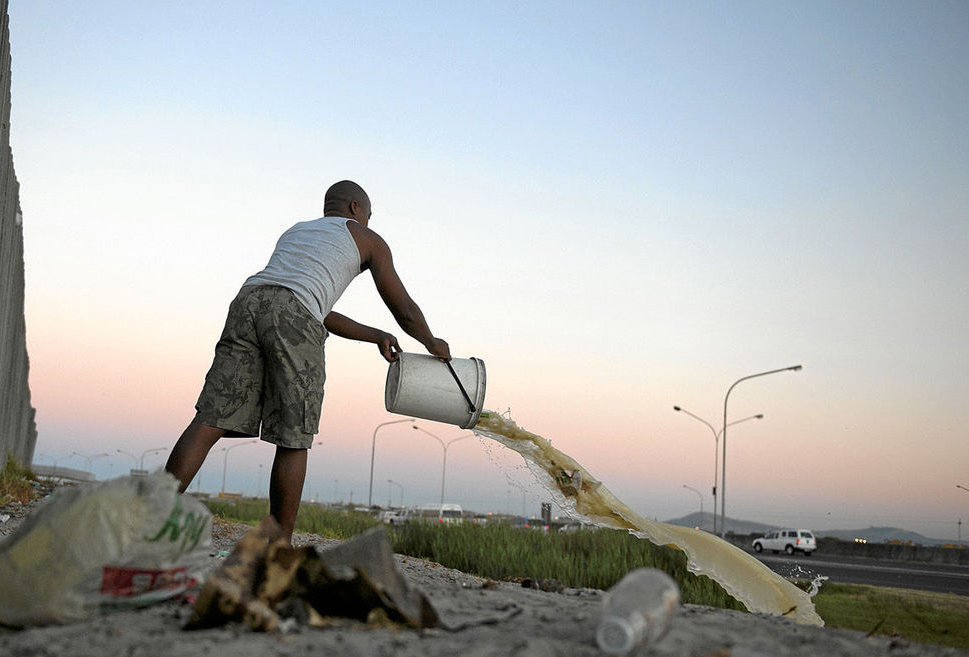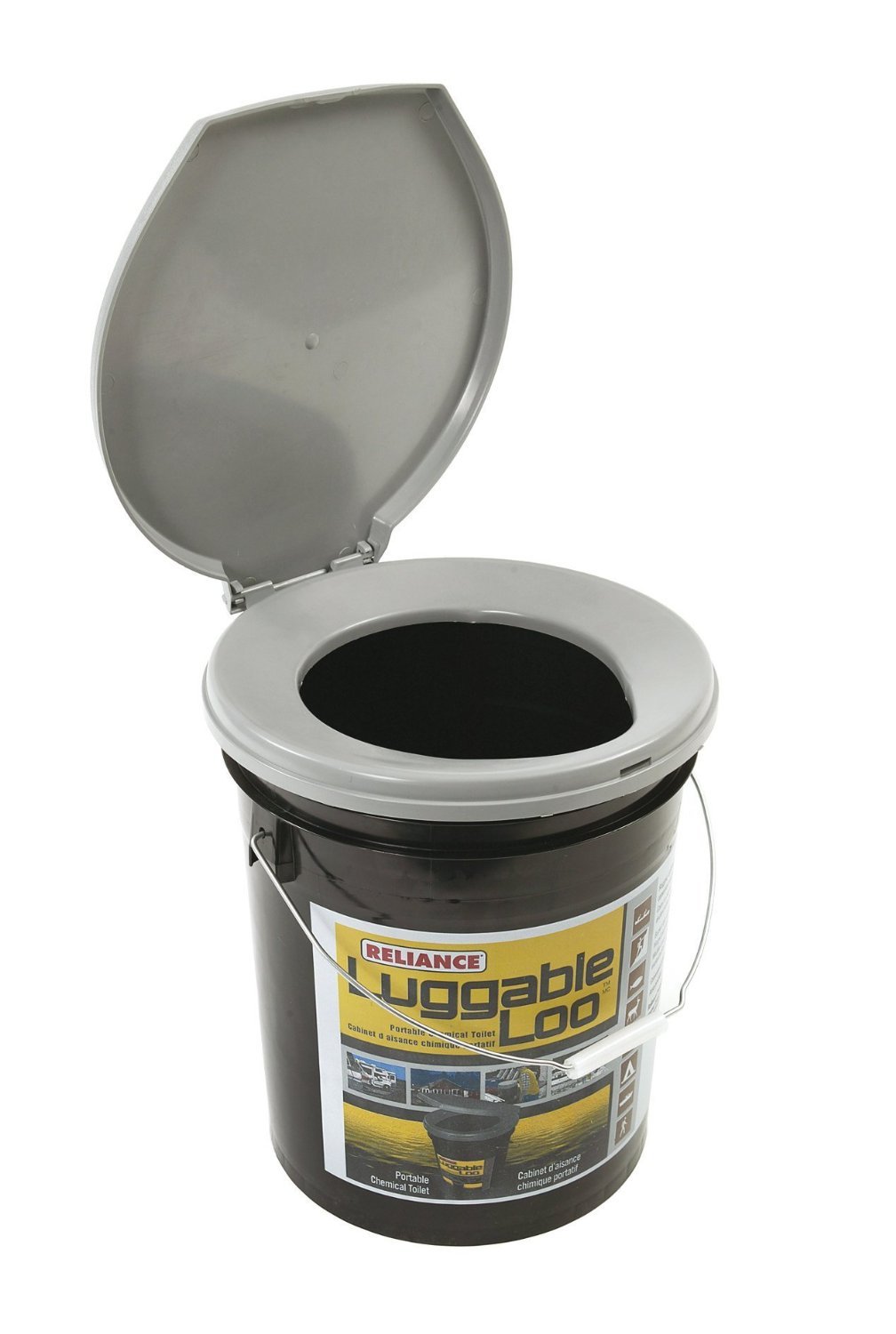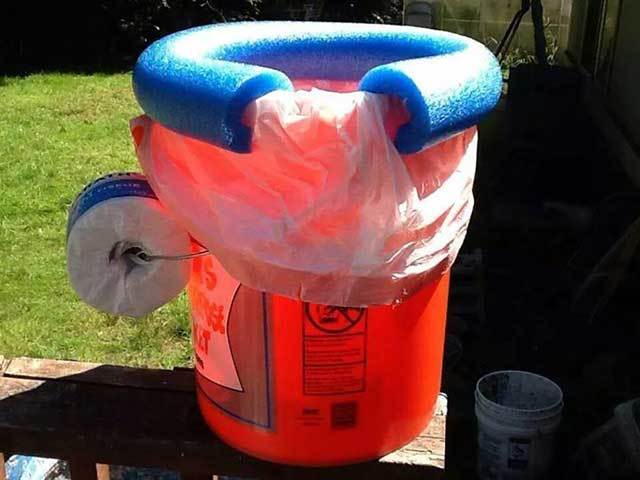
Quick: what do you do if you’re in the city, the grid is down, and the toilet won’t flush? Break out the cat litter, contractor bags, and a trusty 5 gallon bucket, of course!
But how long is that single tub of cat litter in the back of the garage going to last your family? Is your pallet of fifty pound bags actually a year’s supply? We know “one gallon of water per person per day,” but how much litter is needed to clump it all up afterwards?
The role of cat litter in sanitation is to bind up the moisture in the gloppy mess of sewage making it easier to handle, inhibiting bacterial growth, and thus reducing odor. We need enough to bind the moisture and cut the smell to acceptable levels. As you cannot measure smell, this estimation will be based on the amount of water we need to bind.
Why do you need cat litter?
The average human produces about 4.5oz of solid waste per day of which 3.5oz is water [1]. We also produce about 1.5 quarts (3lbs) of liquid waste per day [2]. In total, there is about 3.25lbs of water in our waste per person per day.
There are several kinds of cat litter on the market: clay, clumping clay, silica crystal, and natural litters like pine and paper. What we’re concerned with is how much water an amount of litter can absorb per pound.
Silica-crystal based litters can absorb about 40 times their weight in water [3]. Sodium bentonite clay (‘clumping’ litter) is good for 10-15 times its weight [4], and other clay (non-clumping) is good for half of that – about 6 times its weight [4]. Pine litter can absorb 3 times its weight [5] and cellulose (paper) litter can handle 1.5 times its weight [6].
Read More: Importance of Sanitation after SHTF
Note that a lot of manufacturers give “x times more absorbent than clay” ratings, but don’t tell which clay, per volume or per weight, and so on, so I stuck to claims of “absorbs x times its weight in water” to have a better common point of reference. This could also vary by manufacturer, so read up on your litter of choice to get the most accurate estimate.
These are maximum ratings reported by the sellers, so they are likely spruced up. We have to keep surface area in mind as well: even if you can technically dry your daily solid waste with 0.1oz of silica litter, if that’s not enough to cover the leavings, the litter is not going reach everything without stirring. Gross!
In a stressful emergency situation, no one is going to have the patience to scientifically ration the litter by weight, either. Litter absorbs by the pound, but you will use it by the scoop. Even if you get a scoop sized to your litter’s absorbency (you do have your custom titanium grid-down scoop, right?), you might scoop a level scoop while junior uses heaping scoops.
All this suggests we should build in some wiggle room. Silica is powerful, but also likely to be surface-area restricted. I would estimate silica litter can easily handle 20x of its weight in water, clumping clay litters 10x, clay 3x, pine 2x, and paper 1x. Given that in a sanitation emergency you will need to account for drinking extra water if it is hot or you get sick, we should also round-up the amount of liquids to 4lbs to be safe.
Thus, a fast and loose estimate of the amount of litter you need per person per day is going to be 4lbs divided by the absorbency number above. For instance, silica litter is 20x, so 4lbs divided by 20 is going to be 0.2lbs per person per day. A standard clay litter is 3x. 4lbs divided by 3 is 1.33lbs of clay litter per person per day, or a family of four using a whole 20lb bag of litter in 4 days!
If you’re in a hi-rise where the grid going down will take the sewer pumps with it, it might not be unreasonable to have a week supply of litter, so that family of 4 will need close to 40lbs of standard clay litter! I don’t know about you, but I don’t want to drag that much cat litter up the stairs or find a place to store it. Thankfully, with a bit of planning we can reduce this number by a factor of 8.
Liquid waste is the bigger problem – 3lbs vs 0.25lb of solid. Liquid waste is also sterile, and an airtight lid keeps the smell down, so you could separate solid from liquid and use litter on the solids only without creating too much of a health risk. Even doubling for wiggle room would leave us with 0.5lbs of water in solid waste per person per day. That 20lb bag now lasts a family of four for a whole month!
In practice, this means putting an airtight jar or jug next to your waste receptacle to be emptied into an airtight bucket away from the living space such as in the far corner of your balcony or just outside your door. Keep in mind small children may need instruction and prompting to make sure they’re with the program. The ladies may also appreciate certain accommodations. Talk to them for ideas.
What to do with all that mess?
But what do you do with a full bucket? Depending on fluid intake, you might be dealing with around 1.5 quarts of liquid waste per person per day or 1.5 gallons for four people.
Though liquid waste is sterile, I would not recommend dumping. Venturing outside your apartment in a densely populated area sans utilities is a bad idea to start with, and would you just let someone dump 5 gallons of waste on your lawn? The city might fine you when order is restored as well. You have to do what you have to do, but don’t plan on being that guy!
Eliminate the worry of #2 with this simple makeshift toilet.
I would also avoid depending on your garden, especially a container garden which has no subsoil for the waste to leach into. Liquid waste has high concentrations of salt and nitrates, which most plants can’t handle without dilution. This requires water, which is precious in a grid-down situation. It also risks exposing your food supply to any medications or supplements you’re taking, and if you’re eating heavily preserved foods like MREs, all those chemicals are going into your plants too. Yuck!
Buckets are cheap and stack-able, so it is feasible to maintain 1.5 quarts of bucket per person per day, or 9-10 five gallon buckets per month for a family of four. 15 three gallon buckets would also work if you would rather lug 24lbs at a time rather than 40lbs. Figure out a place to store full buckets and you’ll be all set.
Remember kitty litter and buckets will run out. A week’s supply is a good idea, and a two-week supply will probably be enough for most circumstances. If you’re planning for a month, you would be better off figuring out the logistics for a longer term solution such as a latrine or leach well dug deep into a nearby flower bed.
So there you have it – a “gallon per day” rule of thumb for a cat litter sanitation solution:
First check what type of litter you are buying to figure out its absorbency. Silica crystals: 20x, sodium bentonite clay: 10x. Other clay: 3x. Pine: 2x. Cellulose: 1x.
Divide 4lbs of waste per person per day by the absorbency number above to get a ballpark estimate of how much litter you need. Just like with water, multiply by 2 or 3 if you want to be cautious.
If you have a plan to deal with liquid waste separately, you can get away with replacing the 4lbs above with 0.5lbs, but remember to add extra in case of illness.
Remember that people won’t weigh litter scientifically each time they need to go, so get a grid-down scoop sized for your litter at the dollar store and make sure everyone in your household understands your litter strategy. And don’t forget the needs of your actual cats!
—
References:
[1] Average human solid waste production:
[2] Average human liquid waste production:
[3] Silica litter absorbency:
[4] Clumping and non-clumping litter absorbency:
[5] Pine cat litter absorbency:
[6] Paper cat litter absorbency:






















